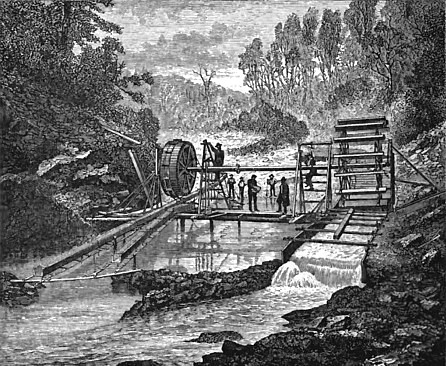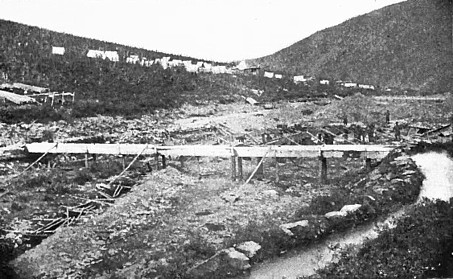'Ground-sluicing' came next; it consisted in bringing water through a ditch to a point above the claim high enough to produce a strong current. Ground-sluicing consists in digging a ditch, either by hand or by the use of a stream of water, which is cut down to bed-rock. If the bed-rock is smooth, boulders and stones are thrown in, often very irregularly, while in other cases they are carefully placed on edge with the upper edge inclined slightly upstream; but if the bed-rock is rough it may serve to arrest the gold, from which irregular depressions it is removed at certain intervals. After the ditch or ground-sluice has been made and prepared with riffles, the work of washing is begun; all of the water and gravel passing through the sluice to the waste bank. Where bedrock or other conditions do not allow the scenario above, a wooden sluice box with riffles is placed at the lower end of the workings to catch and process the gravels. Large quantities of material are shoveled from the sides into the ditch. As the face of the bank recedes the sluice is advanced thus maintaining the same relative position between the two. Many of these sluices may be in close proximity, each having an independent discharge, or several and possibly all may feed one large sluice, which may be a ground-sluice or wooden sluice, in either case provided with some sort of riffles. A the end of the process, the sluice is cleaned, or the stones are removed and the concentrated material collected at the bottom is taken out and put through a rocker or gold pan.
Ground-sluicing is, however, pre-eminently a poor man's method, and the equipment is usually of the roughest sort. In the early days during the California gold rush, ground-sluicing yielded the greater part of the gold produced, but was soon superseded by hydraulic mining and other improved methods by which it was possible to obtain larger returns at small cost. 'Booming' or 'gouging' is somewhat similar to ground sluicing, except that a large quantity of water is collected in a temporary dam above the workings and allowed to rush down suddenly, cutting away large quantities of 'pay dirt' which is conducted through ground-sluices. Booming has had quite extended application in a number of localities in the United States, especially in California and at a later date in Oregon. It was used before the discovery of America, being described by Pliny as a process extensively employed in Spain before the Christian era. It was used to a limited extent in Alaska owing to comparatively slight grades and the disposition of tailing. Booming was introduced to California from Georgia. The dry bars of the rivers that were easy of access at low water, were first worked out. The lower 'bench gravel' was then worked by 'long tom' and other sluices, booming, and gouging, etc.
Booming originated from the method of prospecting known as "hushing" and so-called in Yorkshire, England where it was resorted to in the search for lead-veins. Booming consists in impounding water at some convenient level above the ground to be worked, either by means of ditches or pipes. The impounding dam is provided with a gate which can be suddenly thrown open, permitting a large volume of water to rush down the slope washing out and carrying along with it all loose material. The character of the gate varies largely with the scale of the operation. In California sheets of canvas were occasionally used, being stretched across the opening in the dam and allowed to collapse when a rush of water was desired. However, automatic gates are now generally employed in the larger operations, the actuating device being a water-box which when full dumps and frees the gate. When the water has drained from the dam the gate closes, raising the water box, which in the course of time becomes filled and the operation is repeated. When natural gold is to be collected from the materials thus washed down, some means of catching the gravels must be provided. For this purpose a strongly built flume is constructed at the foot of the slope so arranged as to catch all the water and gravel descending from above. Flumes several thousands of feet in length are often employed in order to ensure the saving of all of the gold.
Another form of gravel mining common in California and elsewhere in the west is river-bed mining. The object of this historical gold mining practice is to recover the gravel forming the beds and bottoms of river channels or streams that are known to be auriferous, but lie below low-water mark. To do this various techniques are resorted to, normally involving draining a section of the river channel, wholly or in part, etc. Where it is sought to drain the whole bed of a stream, the water is diverted by means of dams into a ditch or flume constructed along the bank of the stream to a point below the section to be reclaimed, and there the entire flow is returned to the channel. By this means such section can be so far freed from water that it is possible to control the seepage by pumps, wheels. This allows the normal methods to access the materials, which were once under water. Where there are natural facilities for running tunnels, the entire river-bed can in like manner be diverted into the tunnel and the bed laid bare by such means. When the design is to dry and work only a strip along one side of the riverbed, this is effected by what, in mining parlance, is termed a "wingdam," that is, a water-tight wall which starts from the bank and is carried out a short distance into and down the river, the wall being continued back to the bank. The water inside the space so enclosed is then raised with wheels or hand pumps and emptied into flumes that discharge it into the river.
River-mining is pre-eminently dry season work, being practicable only when the streams are in their low-water stages and resolves itself into a problem of restraint and handling large volumes of water. The mountain streams in which the work is largely confined being fed mainly by melting snows do not materially lessen in volume until June, and restraining dams cannot be built until July, while in November the streams often become swollen again. However, the season varies considerably with different localities but may be said to begin with the receding of the spring floods and continues until the rise of water with the beginning of the fall rains. Occasionally the early fall rains do not affect the streams to such an extent as to seriously interfere with or destroy the mine equipment in the river-bed, while with a period of low-water following, the operations may be prolonged till the winter storms set in. It is evident then that the season is an uncertain quantity varying not only from year to year but for different streams. In California on the Klamath River and its tributaries an eight month season is usual, beginning with the middle of March or the first of April and closing about the first of December. On the Middle Fork of the American River the season begins with the first of May and ends with the first of November, but varies from early in October to late in December. While on the Feather River the season is even shorter, operations beginning about the middle of May and closing at the first of November.
River-mining involves the construction of dams and the extensive use of pumps in order to control the water that the river-bed may be exposed and the gold collected. From the nature of the appliances then and their location in the river-bed they cannot be maintained from season to season but must be taken down if possible on the occurrence of a rise of water and assembled again for each season's work. Furthermore, it is not infrequently the case that the work of preparing a plant for operation leaves only a few days for actual mining, before a sudden rise of water wrecks or entirely sweeps away in a few hours the work of months. Operators often consider themselves fortunate if an uninterrupted period of 20 to 30 days is had, but an output of $500 to $5,000 per day is not uncommon and usually well repays the labor and expense of fitting up.
Continue on to:
River Mining and Ground Sluicing for Gold – Part II
Return To:
Historic Placer Mining Technologies


